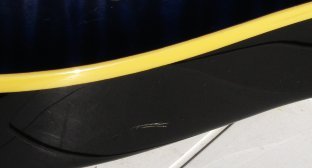Guitar Scratch Remover Review
Warning: 'Guitar Scratch Remover' is only effective and safe at removing and polishing scratches on high gloss clear-coated factory finishes, on both electric and acoustic guitars.
Click here to scroll down to the list of cases when not to use this product.
Below is the story how I decided to buy 'Guitar Scratch Remover - Player's Kit Standard' and what results I got. I photographed my guitar just before applying the product and after to see how well it's really going to work in my real life situation.
Some time ago I bought the pre-owned electric guitar Cort M600T. Generally the guitar was in the good condition, but a few scratches in its finish at the top of the body slightly irritated me.
I really don't like scratches on a beautiful guitar body.


First I thought a scratch is a scratch and there's not much I can do about that. Anyway I typed something like "how to remove scratches on the guitar" in the online search, hoping to get good advice.
I found some tips on how to make scratches less noticeable and prevent them from growing. One of the many websites I've been to was the 'Guitar Scratch Remover' website with the unbelievable photos and videos where they showed off guitars before and after applying their product to the high gloss scratched finishes.
In the beginning I thought these videos might be deceiving to make people buy, as so many others on the net. To check more about the remedy I clicked "watch the video on youtube" button to read the comments above. The comments mostly were positive and I started believing that this might help.
So I decided to give it a try and ordered the "Player's Kit Standard" package. It cost just about US$20 plus a few $ for shipping. Big money was not at risk.
The package included two tubes with the instrument polish to cover a wide range of polishes: #1 - red label and #2 - blue label, plus a regular microfiber towel. For some types of finish and scratches the #1 tube works better and for others the #2. They both are OK to use on electrics and acoustics. I used them only on my electric guitar so far.
When I received the 'Guitar Scratch Remover', I read the manual and started to work on my guitar. First I rubbed the polish #1 around the scratches with the microfiber towel from the kit. 5 minutes of work and the scratches which were painful on the eyes really diminished and sometimes were hardly visible. After that I switched to the #2 blend with the blue label, and did the same.
Slowly-slowly the scratches almost totally disappeared. The little tails of them were the most difficult to remove though. I alternately applied the #1 and #2 blend a few times and finally completely removed the scratches on the top of the guitar body. The whole process of removing these scratches took around 20-30 minutes.


After that I began to remove the thin minor scratch near the bottom of the guitar where the finish was actually the same as on the top. Strangely but this one was very difficult to remove. (I didn't publish the photo of this scratch because couldn't take a clean picture of it.)
I was switching between the #1 and #2 blend many times in a couple of sessions, hardly rubbing the remedy at the guitar body over the scratch. Only after this the scratch had almost completely gone. But even now I can still see a very thin part of it when looking at the spot from close proximity and only at a certain angle.
At the bottom side of the guitar I had a dent that caused the white crack in the black glossy finish. Applying the 'scratch remover' to this crack didn't make any change really. By the way, the manual warns not to use "Guitar Scratch Remover" on flawed finishes as it can make things worse. In my case the crack was hidden from the eyes and I had a try.

It's important to carefully read the whole manual that goes with the product before you start polishing.
Besides the tips on how to effectively apply the product and get the fastest and best results, you'll also find information that will help you prevent damaging your existing finish by misuse of the product, as well as a number of cases when you shouldn't use it at all.
Below are important warnings from the manual, I've put them on this page so you could decide if this product is right for you before buying.
Do not use Guitar Scratch Remover on: matte, non-gloss, semi-gloss, flat, thin, or satin finishes as damage is possible: these finishes have a dull or little shine and do not show crisp, glossy reflections.
This includes non-gloss fretboards and necks. Not compatible with some Rickenbacker models.
Be aware some guitars have both glossy and satin finishes on different surfaces. This remedy is safe and works only on glossy finishes. Do not use on worn-out or damaged finishes. First test the product in a small inconspicuous area.
It is not advised to use any polish on very high-value or collector's items.
Older finishes that have deteriorated and become porous shouldn't be treated with any polish. Not to use on flawed finishes.
